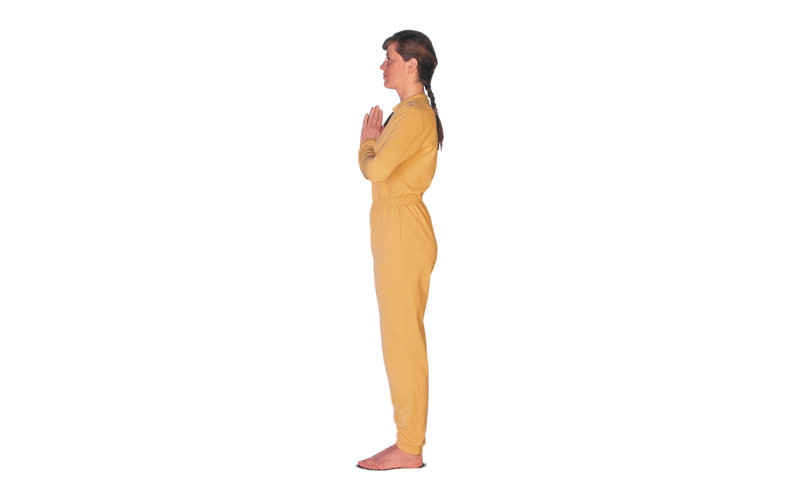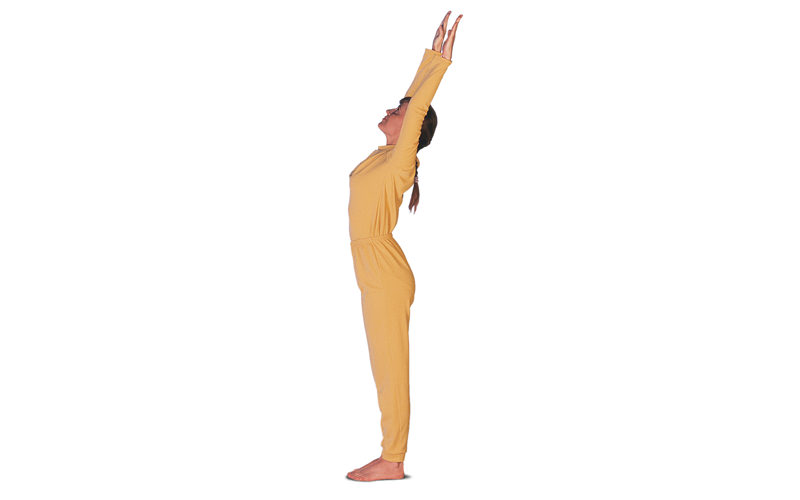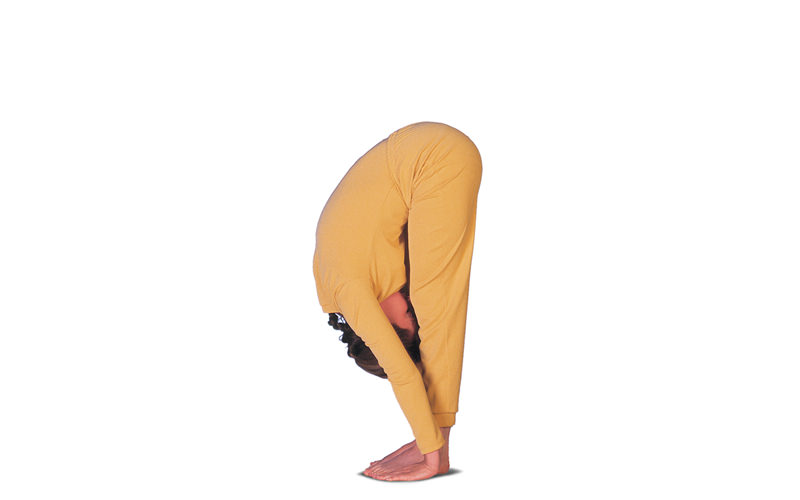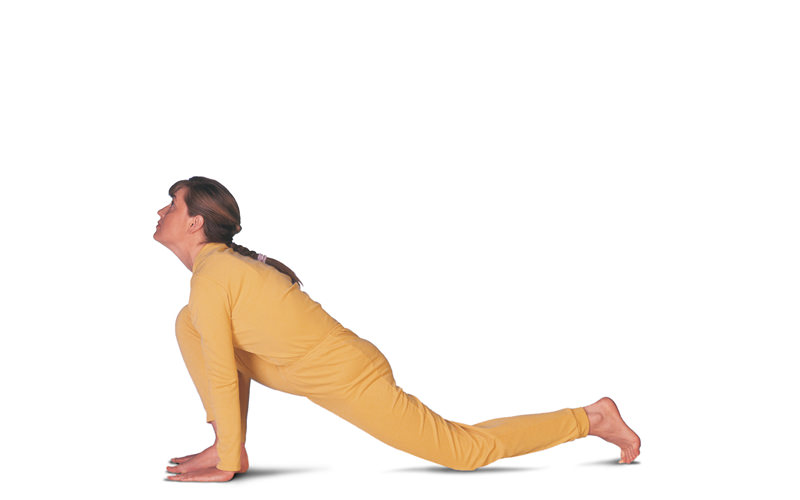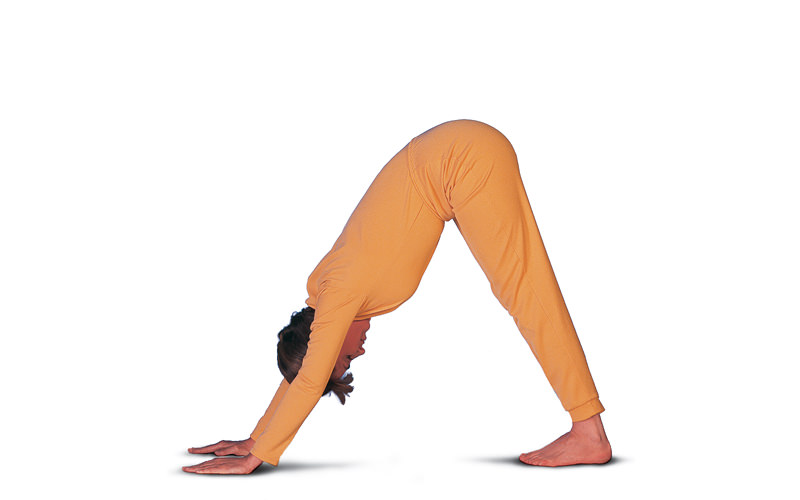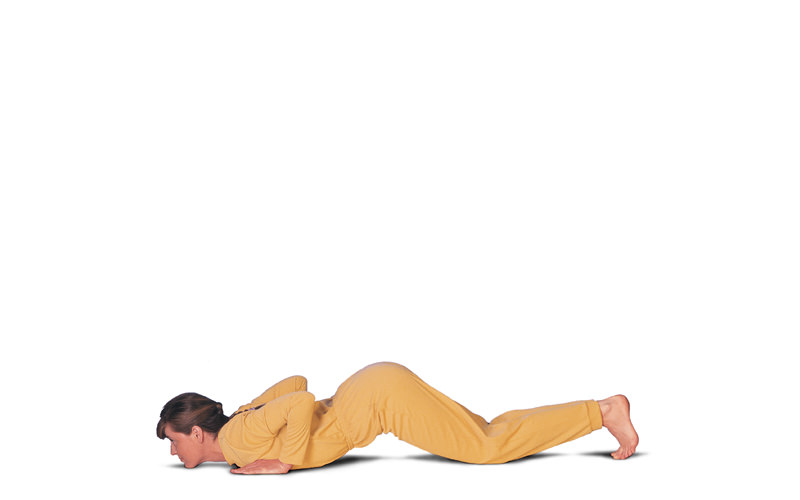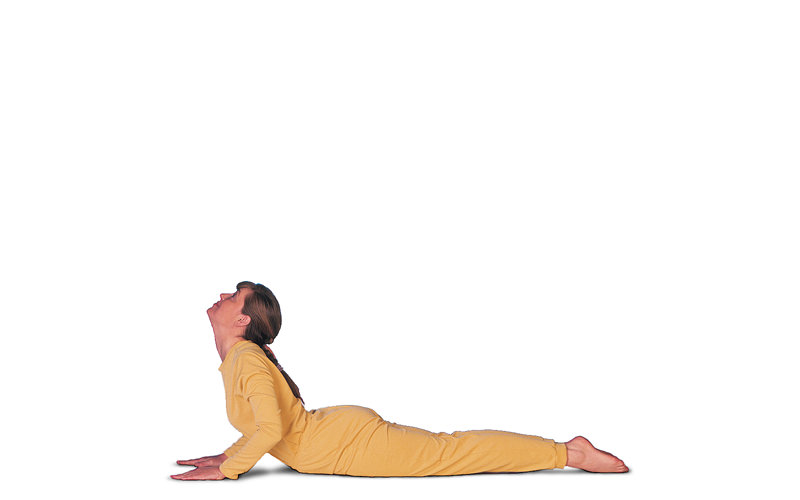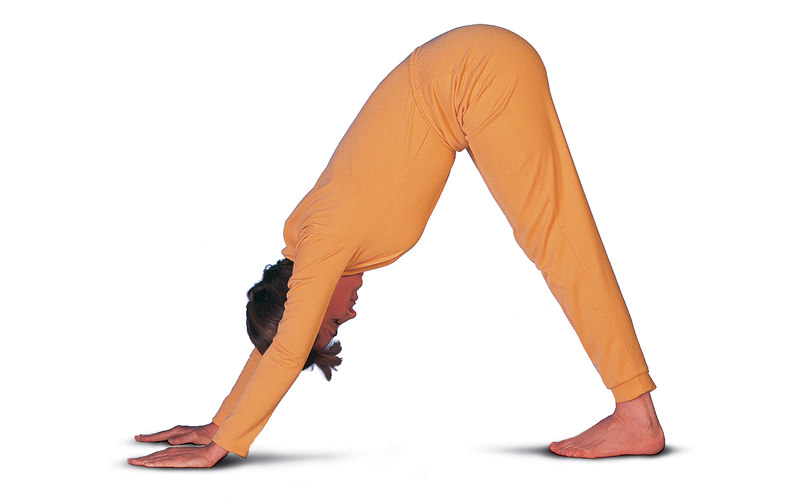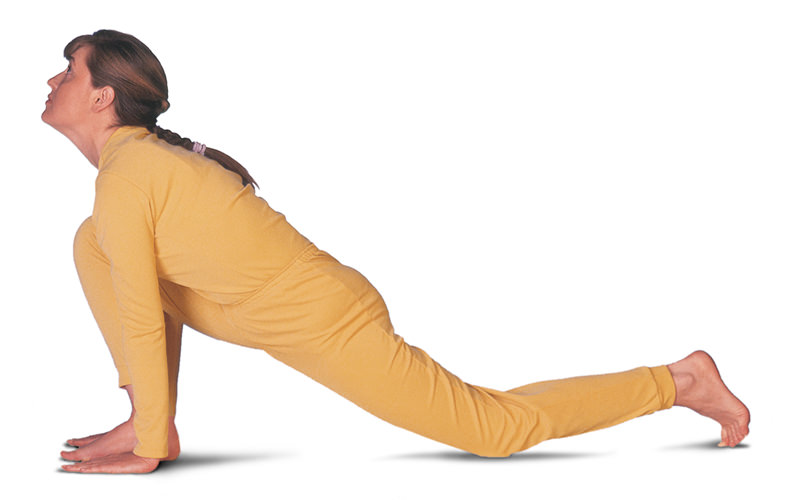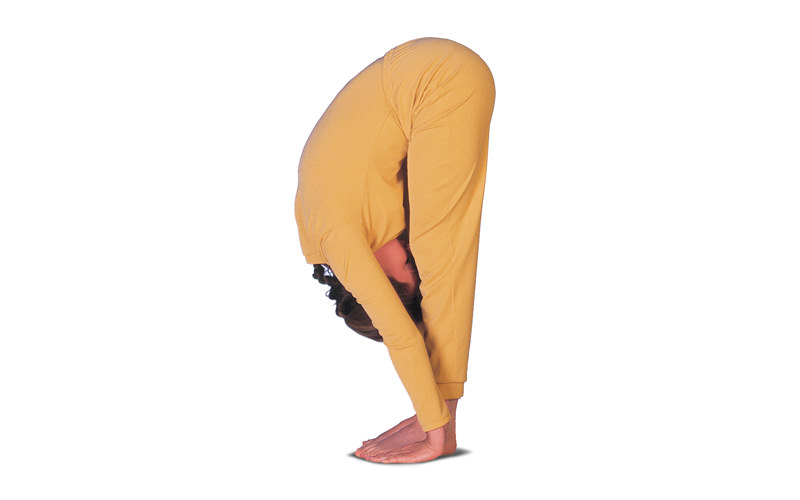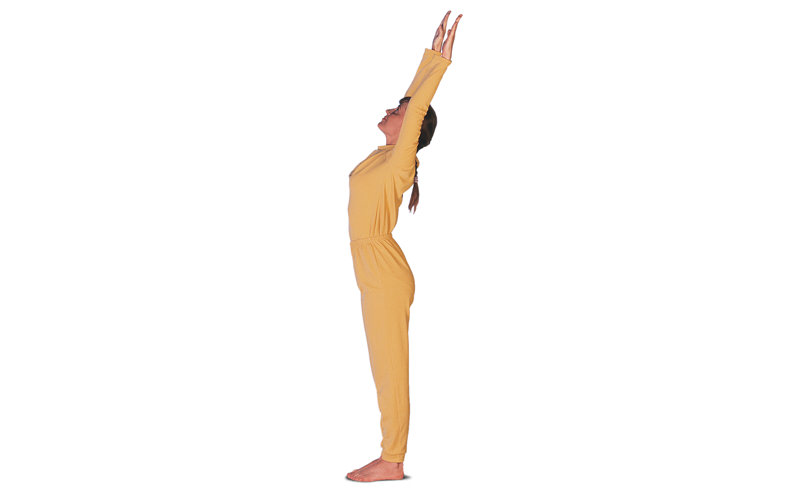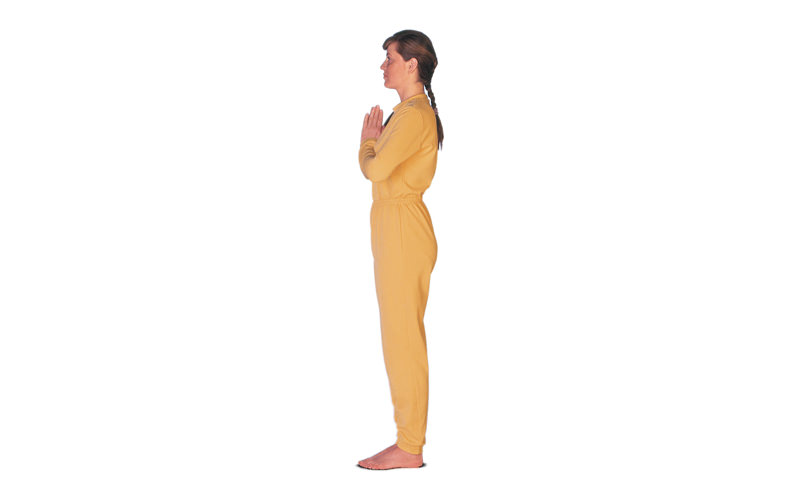Starting Position:
Standing (with legs together)
Concentration:
on the position of the relevant Chakra or on the whole body
Breath:
coordinate with movement, or normal breathing in the position
Repetitions:
2–12 rounds
Practice:
Stand with legs together and concentrate on the whole body.
-
Bring palms together in front of the chest.
-
Inhaling keep arms parallel and raise them above the head. Palms face the front. Look up.
-
Exhaling bend forward until the palms or fingers touch the floor beside the feet, or as far as possible. The knees remain straight.
-
Inhaling take a long step backwards with the left leg and place the knee on the floor. The toes of the left foot are tucked under. The right foot remains between the hands with the sole of the foot flat on the floor. Look up.
-
Exhaling bring the right foot back beside the left, raise the buttocks and straighten the legs. Look towards the navel. The soles of both feet stay flat on the floor. The body weight is equally distributed between the hands and feet. Hips are raised so the body looks like a mountain.
-
Holding the breath bring the knees, chin and chest to the floor. The toes are tucked under and hips are lifted from the floor. Concentrate on the whole body. Arms are bent with elbows tucked in and hands under shoulders.
-
Inhaling press the hips to the floor and lift the trunk upright (Bhujangasana). The feet lie flat along the floor and hands are under the shoulders.
-
Exhaling, tuck the toes under and raise the buttocks high, straighten the legs and look towards the navel. The soles of both feet stay flat on the floor. The body’s weight is equally distributed between hands and feet.
-
Inhaling bring the left leg forward with a large step. Lower the right knee to the floor and tuck the toes of the right foot under. The left foot is between the hands. The sole of the foot is flat on the floor. Look up.
-
Exhaling place the right foot beside the left and straighten the legs. The upper body hangs down, the palms or fingers touch the floor. Knees remain straight.
-
Inhaling keep both arms parallel, raise them above the head and look up.
-
Exhaling lower the hands into prayer position at chest level and return to the starting position.
-
These 12 positions form one round. In the next round, step the right leg back in Position 4 and forward in Position 9. Alternate the legs in each round.
Surya Namaskara with Mantra and Concentration on the Chakras.
The sun symbolises light, purity, clarity and consciousness. Regular practice of Surya Namaskara imparts the power and radiance of the sun, that is why it is known as “Salute to the Sun”.
This practice can also be performed with special concentration on each Chakra, with the corresponding Surya Namaskara Mantra chanted or repeated mentally before the change of each position.
| Position | Mantra | Concentrate on |
|---|---|---|
| 1 | OM MITRĀYA NAMAHA | ANAHATA CHAKRA |
| 2. | OM RAVAYE NAMAHA | VISHUDDHI CHAKRA |
| 3. | OM SŪRYĀYA NAMAHA | MANIPURA CHAKRA |
| 4. | OM BHĀNAVE NAMAHA | ANAHATA CHAKRA |
| 5. | OM KHAGĀYA NAMAHA | SAHASRARA CHAKRA |
| 6. | OM PŪSHNE NAMAHA | THE WHOLE BODY |
| 7. | OM HIRANYAGARBHĀYA NAMAHA | SVADHISHTHANA CHAKRA |
| 8. | OM MARĪCHAYE NAMAHA | SAHASRARA CHAKRA |
| 9. | OM SAVITRE NAMAHA | ANAHATA CHAKRA |
| 10. | OM ARKĀYA NAMAHA | MANIPURA CHAKRA |
| 11. | OM ĀDITYĀYA NAMAHA | VISHUDDHI CHAKRA |
| 12. | OM BHASKARĀYA NAMAHA | ANAHATA CHAKRA |
The Benefits of the Individual Positions:
-
Position 1 + 12:
Improves the ability to concentrate and calms the nervous system and mind. The Anahata Chakra is balanced.
-
Position 2 + 11:
The front of the body is open and stretched, stimulating blood circulation. The Vishuddhi Chakra is stimulated. Beneficial for chronic throat problems.
-
Position 3 + 10:
Stretches the back muscles and the muscles at the back of the thighs. Activates the solar plexus and the Manipura Chakra. The digestive system is stimulated. The head receives a good supply of blood, which has a favourable influence upon the eyes, ears and memory.
-
Position 4 + 9:
The pressure of the thigh stimulates the digestive organs. The leg and back muscles are strengthened. The Anahata Chakra, solar plexus and Manipura Chakra are balanced.
-
Position 5 + 8:
Regulates the nervous system. Strengthens arm, leg and back muscles and stretches muscles at the back of the legs. The increased blood supply to the head has a favourable influence upon brain functions, eyes and ears, and stimulates the Sahasrara Chakra.
-
Position 6:
Encourages diaphragmatic breathing, stretches the spine and is beneficial on lower abdominal organs. Balances the whole body.
-
Position 7:
Strengthens arm, shoulder and back muscles. Promotes flexibility of the spine and improves posture, thereby helping to prevent slipped discs. Stimulates digestive function. The Svadhishthana Chakra is balanced.
Benefits:
Stimulates circulation, improves physical fitness, the ability to concentrate, mental stability and spiritual development.
Caution:
Avoid this sequence with high blood pressure or dizziness.
After this exercise relax in Anandasana.
Asana is included in the following categories:
Asanas and Exercises to Stimulate Circulation
Asanas and Exercises for Depression
